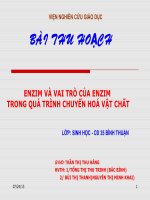en CCNAS v11 ch07 cryptographic systems
Bạn đang xem bản rút gọn của tài liệu. Xem và tải ngay bản đầy đủ của tài liệu tại đây (1.71 MB, 159 trang )
Cryptographic Systems
© 2012 Cisco and/or its affiliates. All rights reserved.
1
Managing Administrative Access
• A network LAN can be secured through:
– Device hardening
– AAA access control
– Firewall features
– IPS implementations
• How is network traffic protected when traversing the public
Internet?
– Using cryptographic methods
© 2012 Cisco and/or its affiliates. All rights reserved.
2
Secure Communications Requires …
Authentication
Integrity
Confidentiality
© 2012 Cisco and/or its affiliates. All rights reserved.
3
Authentication
• Authentication guarantees that the message:
– Is not a forgery.
– Does actually come from who it states it comes from.
• Authentication is similar to a secure PIN for banking at an ATM.
– The PIN should only be known to the user and the financial institution.
– The PIN is a shared secret that helps protect against forgeries.
© 2012 Cisco and/or its affiliates. All rights reserved.
4
Authentication
• Data nonrepudiation is a similar service that allows the sender of
a message to be uniquely identified.
• This means that a sender / device cannot deny having been the
source of that message.
– It cannot repudiate, or refute, the validity of a message sent.
© 2012 Cisco and/or its affiliates. All rights reserved.
5
Integrity
• Data integrity ensures that messages are not altered in transit.
– The receiver can verify that the received message is identical to the sent
message and that no manipulation occurred.
• European nobility ensured the data integrity by creating a wax
seal to close an envelope.
– The seal was often created using a signet ring.
– An unbroken seal on an envelope guaranteed the integrity of its contents.
– It also guaranteed authenticity based on the unique signet ring impression.
© 2012 Cisco and/or its affiliates. All rights reserved.
6
Confidentiality
• Data confidentiality ensures privacy so that only the receiver can
read the message.
• Encryption is the process of scrambling data so that it cannot be
read by unauthorized parties.
– Readable data is called plaintext, or cleartext.
– Encrypted data is called ciphertext.
• A key is required to encrypt and decrypt a message.
– The key is the link between the plaintext and ciphertext.
© 2012 Cisco and/or its affiliates. All rights reserved.
7
Managing Administrative Access
• Authentication, integrity, and confidentiality are components of
cryptography.
• Cryptography is both the practice and the study of hiding
information.
• It has been used for centuries to protect secret documents.
– Today, modern day cryptographic methods are used in multiple ways to
ensure secure communications.
© 2012 Cisco and/or its affiliates. All rights reserved.
8
History of
Cryptography
© 2012 Cisco and/or its affiliates. All rights reserved.
9
Scytale
• Earliest cryptography method.
– Used by the Spartans in ancient Greece.
© 2012 Cisco and/or its affiliates. All rights reserved.
10
Scytale
• It is a rod used as an aid for a transposition cipher.
– The sender and receiver had identical rods (scytale) on which to wrap a
transposed messaged.
© 2012 Cisco and/or its affiliates. All rights reserved.
11
Caesar Cipher
• When Julius Caesar sent messages
to his generals, he didn't trust his
messengers.
• He encrypted his messages by
replacing every letter:
–
A with a D
–
B with an E
–
and so on
• His generals knew the "shift by 3"
rule and could decipher his
messages.
© 2012 Cisco and/or its affiliates. All rights reserved.
12
Vigenère Cipher
• In 1586, Frenchman Blaise de
Vigenère described a poly
alphabetic system of encryption.
–
It became known as the Vigenère Cipher.
• Based on the Caesar cipher, it
encrypted plaintext using a multiletter key.
–
It is also referred to as an autokey cipher.
© 2012 Cisco and/or its affiliates. All rights reserved.
13
Note of interest …
• It took 300 years for the
Vigenère Cipher to be broken by
Englishman Charles Babbage.
– Father of modern computers
• Babbage created the first
mechanical computer called the
difference engine to calculate
numerical tables.
– He then designed a more
complex version called the
analytical engine that could use
punch cards.
– He also invented the pilot (cowcatcher).
© 2012 Cisco and/or its affiliates. All rights reserved.
14
Confederate Cipher Disk
• Thomas Jefferson, the third
president of the United States,
invented an encryption system that
was believed to have been used
when he served as secretary of
state from 1790 to 1793.
© 2012 Cisco and/or its affiliates. All rights reserved.
15
German Enigma Machine
• Arthur Scherbius invented the
Enigma in 1918 and sold it to
Germany.
–
It served as a template for the machines
that all the major participants in World War
II used.
• It was estimated that if 1,000
cryptanalysts tested four keys per
minute, all day, every day, it would
take 1.8 billion years to try them all.
–
Germany knew their ciphered messages
could be intercepted by the allies, but
never thought they could be deciphered.
/>© 2012 Cisco and/or its affiliates. All rights reserved.
16
Code Talkers
• During World War II, Japan was deciphering every code the
Americans came up with.
– A more elaborate coding system was needed.
– The answer came in the form of the Navajo code talkers.
• Code talkers were bilingual Navajo speakers specially recruited
during World War II by the Marines.
• Other Native American code talkers were Cherokee, Choctaw and
Comanche soldiers.
© 2012 Cisco and/or its affiliates. All rights reserved.
17
Code Talkers
• Not only were there no words in the
Navajo language for military terms,
the language was unwritten and less
than 30 people outside of the
Navajo reservations could speak it,
and not one of them was Japanese.
–
By the end of the war, more than 400
Navajo Indians were working as code
talkers.
© 2012 Cisco and/or its affiliates. All rights reserved.
18
Cipher Text
© 2012 Cisco and/or its affiliates. All rights reserved.
19
Cipher Text
• A cipher is a series of well-defined steps that can be followed as a
procedure when encrypting and decrypting messages.
• Each encryption method uses a specific algorithm, called a cipher,
to encrypt and decrypt messages.
• There are several methods of creating cipher text:
– Transposition
– Substitution
– Vernam
© 2012 Cisco and/or its affiliates. All rights reserved.
20
Transposition Ciphers
• In transposition ciphers, no letters are replaced; they are simply
rearranged.
• For example:
– Spell it backwards.
• Modern encryption algorithms, such as the DES (Data Encryption
Standard) and 3DES, still use transposition as part of the
algorithm.
© 2012 Cisco and/or its affiliates. All rights reserved.
21
Transposition Rail Fence Cipher
1
Solve the ciphertext.
FKTTAW
LNESATAKTAN
AATCD
Ciphered text
2
Use a rail fence cipher and a key of 3.
3
The clear text message.
F...K...T...T...A...W.
.L.N.E.S.A.T.A.K.T.A.N
..A...A...T...C...D...
FLANK EAST
ATTACK AT DAWN
Clear text
© 2012 Cisco and/or its affiliates. All rights reserved.
22
Substitution Cipher
• Substitution ciphers substitute one letter for another.
– In their simplest form, substitution ciphers retain the letter frequency of the
original message.
• Examples include:
– Caesar Cipher
– Vigenère Cipher
© 2012 Cisco and/or its affiliates. All rights reserved.
23
Let’s Encode using the Caesar Cipher!
1
The cleartext message.
FLANK EAST
ATTACK AT DAWN
Clear text
2
Encode using a key of 3. Therefore, A becomes a D, B an E, …
A B C D E F G H I J K L M N O P Q R S T U V W X Y Z
A B C D E F G H I J K L M N O P Q R S T U V W X Y Z A B C
3
The encrypted message becomes …
IODQN HDVW
DWWDFN DW GDZQ
Ciphered text
© 2012 Cisco and/or its affiliates. All rights reserved.
24
Let’s Decode
1
Solve the ciphertext.
OZ OY IUUR
Ciphered text
2
Use a shift of 6 (ROT6).
A B C D E F G H I J K L M N O P Q R S T U V W X Y Z
A B C D E F G H I J K L M N O P Q R S T U V W X Y Z A B C D E F G H I J K L M
3
The clear text message.
IT is cool
Clear text
© 2012 Cisco and/or its affiliates. All rights reserved.
25









